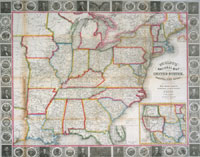Treaty of Walla Walla
Advice to Travelers
Descendants of Petamyo Mox Mox
| | |
Advice to Travelers
When negotiating the Treaty of Walla-Walla and other similar agreements,
Governor Isaac Stevens had assured the Oregon and Washington tribes that their
new homelands would be reserved for their exclusive use. However, three years
after the treaty was signed, Stevens published A Circular Letter to Emigrants
Desirous of Locating in the Washington Territory. In it, he described
the Columbia River country’s mild climate and fertile land and praised
the region’s abundant fisheries and densely forested mountains. Notably,
he did not mention the local tribes; nor did he point out that thousands of
square miles of the Northwest were guaranteed to Indians by federal treaty,
and were therefore not available for settlement.
Just as many of the emigrants to Oregon were unaware of the local Indians’ treaty rights, tribal leaders in the 1850s did not know that east of the Rockies men like Humphrey Phelps were making a living by encouraging Americans to travel west and invade their homelands.
At the treaty grounds where the negotiating sessions for the Treaty of Walla-Walla took place, one of the government representatives had warned the Indians that they needed a secure title to their lands because whites would soon arrive in unimaginable numbers. He told the chiefs that new settlers would appear “like grasshoppers on the plains.” Phelps’s Guide Through the United States--filled with steamboat, railroad, and canal schedules--would help make that prediction come true.
Phelps’s Travellers’ Guide Through the United States; Containing Upwards of Seven Hundred Rail-road, Canal, and Stage and Steamboat Routes, Accompanied with a New Map of the United States, 1849.
|

| Click to Enlarge | Newberry Library |
|

